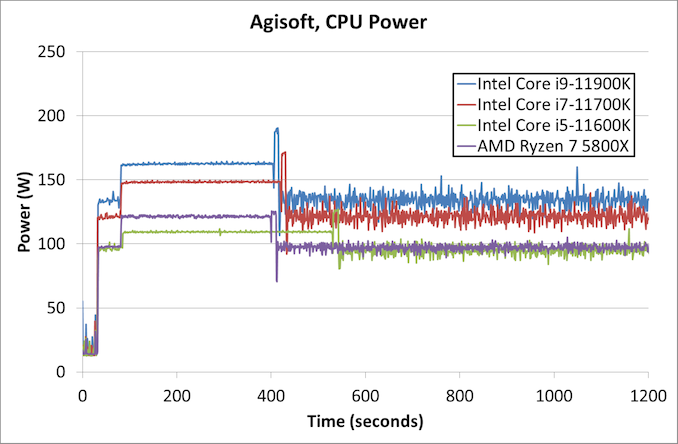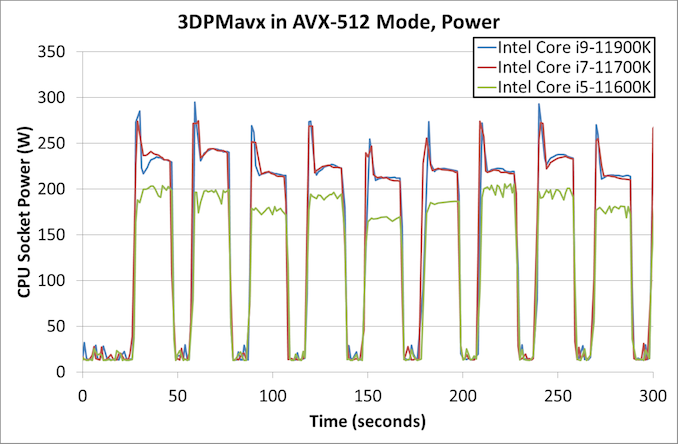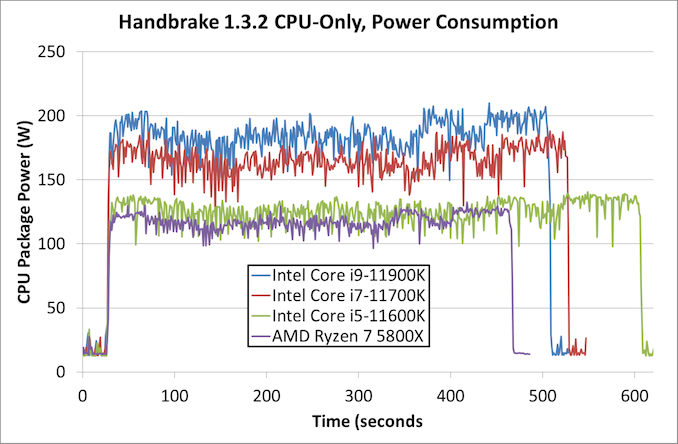Intel Rocket Lake (14nm) Review: Core i9-11900K, Core i7-11700K, and Core i5-11600K
by Dr. Ian Cutress on March 30, 2021 10:03 AM EST- Posted in
- CPUs
- Intel
- LGA1200
- 11th Gen
- Rocket Lake
- Z590
- B560
- Core i9-11900K
Power Consumption: AVX-512 Caution
I won’t rehash the full ongoing issue with how companies report power vs TDP in this review – we’ve covered it a number of times before, but in a quick sentence, Intel uses one published value for sustained performance, and an unpublished ‘recommended’ value for turbo performance, the latter of which is routinely ignored by motherboard manufacturers. Most high-end consumer motherboards ignore the sustained value, often 125 W, and allow the CPU to consume as much as it needs with the real limits being the full power consumption at full turbo, the thermals, or the power delivery limitations.
One of the dimensions of this we don’t often talk about is that the power consumption of a processor is always dependent on the actual instructions running through the core. A core can be ‘100%’ active while sitting around waiting for data from memory or doing simple addition, however a core has multiple ways to run instructions in parallel, with the most complex instructions consuming the most power. This was noticeable in the desktop consumer space when Intel introduced vector extensions, AVX, to its processor design. The concurrent introduction of AVX2, and AVX512, means that running these instructions draws the most power.
AVX-512 comes with its own discussion, because even going into an ‘AVX-512’ mode causes additional issues. Intel’s introduction of AVX-512 on its server processors showcased that in order to remain stable, the core had to reduce the frequency and increase the voltage while also pausing the core to enter the special AVX-512 power mode. This made the advantage of AVX-512 suitably only for strong high-performance server code. But now Intel has enabled AVX-512 across its product line, from notebook to enterprise, with the running AI code faster, and enabling a new use cases. We’re also a couple of generations on from then, and AVX-512 doesn’t get quite the same hit as it did, but it still requires a lot of power.
For our power benchmarks, we’ve taken several tests that represent a real-world compute workload, a strong AVX2 workload, and a strong AVX512 workload.
Starting with the Agisoft power consumption, we’ve truncated it to the first 1200 seconds as after that the graph looks messy. Here we see the following power ratings in the first stage and second stage:
- Intel Core i9-11900K (1912 sec): 164 W dropping to 135 W
- Intel Core i7-11700K (1989 sec): 149 W dropping to 121 W
- Intel Core i5-11600K (2292 sec): 109 W dropping to 96 W
- AMD Ryzen 7 5800X (1890 sec): 121 W dropping to 96 W
So in this case, the heavy second section of the benchmark, the AMD processor is the lowest power, and quickest to finish. In the more lightly threaded first section, AMD is still saving 25% of the power compared to the big Core i9.
One of the big takeaways from our initial Core i7-11700K review was the power consumption under AVX-512 modes, as well as the high temperatures. Even with the latest microcode updates, both of our Core i9 parts draw lots of power.
The Core i9-11900K in our test peaks up to 296 W, showing temperatures of 104ºC, before coming back down to ~230 W and dropping to 4.5 GHz. The Core i7-11700K is still showing 278 W in our ASUS board, tempeartures of 103ºC, and after the initial spike we see 4.4 GHz at the same ~230 W.
The Core i5-11600K, with fewer cores, gets a respite here. Our peak power numbers are around the 206 W range, with the workload not doing an initial spike and staying around 4.6 GHz. Peak temperatures were at the 82ºC mark, which is very manageable. During AVX2, the i5-11600K was only at 150 W.
Moving to another real world workload, here’s what the power consumption looks like over time for Handbrake 1.3.2 converting a H.264 1080p60 file into a HEVC 4K60 file.
This is showing the full test, and we can see that the higher performance Intel processors do get the job done quicker. However, the AMD Ryzen 7 processor is still the lowest power of them all, and finishes the quickest. By our estimates, the AMD processor is twice as efficient as the Core i9 in this test.
Thermal Hotspots
Given that Rocket Lake seems to peak at 104ºC, and here’s where we get into a discussion about thermal hotspots.
There are a number of ways to report CPU temperature. We can either take the instantaneous value of a singular spot of the silicon while it’s currently going through a high-current density event, like compute, or we can consider the CPU as a whole with all of its thermal sensors. While the overall CPU might accept operating temperatures of 105ºC, individual elements of the core might actually reach 125ºC instantaneously. So what is the correct value, and what is safe?
The cooler we’re using on this test is arguably the best air cooling on the market – a 1.8 kilogram full copper ThermalRight Ultra Extreme, paired with a 170 CFM high static pressure fan from Silverstone. This cooler has been used for Intel’s 10-core and 18-core high-end desktop variants over the years, even the ones with AVX-512, and not skipped a beat. Because we’re seeing 104ºC here, are we failing in some way?
Another issue we’re coming across with new processor technology is the ability to effectively cool a processor. I’m not talking about cooling the processor as a whole, but more for those hot spots of intense current density. We are going to get to a point where can’t remove the thermal energy fast enough, or with this design, we might be there already.
I will point out an interesting fact down this line of thinking though, which might go un-noticed by the rest of the press – Intel has reduced the total vertical height of the new Rocket Lake processors.
The z-height, or total vertical height, of the previous Comet Lake generation was 4.48-4.54 mm. This number was taken from a range of 7 CPUs I had to hand. However, this Rocket Lake processor is over 0.1 mm smaller, at 4.36 mm. The smaller height of the package plus heatspreader could be a small indicator to the required thermal performance, especially if the airgap (filled with solder) between the die and the heatspreader is smaller. If it aids cooling and doesn’t disturb how coolers fit, then great, however at some point in the future we might have to consider different, better, or more efficient ways to remove these thermal hotspots.
Peak Power Comparison
For completeness, here is our peak power consumption graph.

Platform Stability: Not Complete
It is worth noting that in our testing we had some issues with platform stability with our Core i9 processor. Personally, across two boards and several BIOS revisions, I would experience BSODs in high memory use cases. Gavin, our motherboard editor, was seeing lockups during game tests with his Core i9 on one motherboard, but it worked perfectly with a second. We’ve heard about issues of other press seeing lockups, with one person going through three motherboards to find stability. Conversations with an OEM showcased they had a number of instability issues running at default settings with their Core i9 processors.
The exact nature of these issues is unknown. One of my systems refused to post with 4x32 GB of memory, only with 2x32 GB of memory. Some of our peers that we’ve spoken to have had zero problems with any of their systems. For us, our Core i7 and Core i5 were absolutely fine. I have a second Core i9 processor here which is going through stability tests as this review goes live, and it seems to be working so far, which might point that it is a silicon/BIOS issue, not a memory issue.
Edit: As I was writing this, the second Core i9 crashed and restarted to desktop.
We spoke to Intel about the problem, and they acknowledged our information, stating:
We are aware of these reports and actively trying to reproduce these issues for further debugging.
Some motherboard vendors are only today putting out updated BIOSes for Intel’s new turbo technology, indicating that (as with most launches) there’s a variety of capability out there. Seeing some of the comments from other press in their reviews today, we’re sure this isn’t an isolated incident; however we do expect this issue to be solved.













279 Comments
View All Comments
vanish1 - Tuesday, March 30, 2021 - link
Best thing about Intel CPUs is you dont need a dGPU to make them work nor only limit your selection to APUs from AMD.If youre building a computer right now and you dont already have a GPU then there is zero value in any AMD CPU currently.
BushLin - Tuesday, March 30, 2021 - link
So it's the only option for someone who builds their own gaming PCs but doesn't have a GPU from the last ~6 years to offer better than crappy dGPU performance...vanish1 - Tuesday, March 30, 2021 - link
^No idea what youre trying to say29a - Wednesday, March 31, 2021 - link
He's trying to say if you've got a 6 year old dGPU it will outperform Intel's iGPU.BushLin - Wednesday, March 31, 2021 - link
Thanks for that, yes, well deduced. Can't fix typos, substitute dGPU for iGPU and hopefully makes sense.Also, I'd rather pay over the odds for an old, bottom tier RX 550 than game on a poor iGPU and that's from someone who only buys Nvidia.
vanish1 - Thursday, April 1, 2021 - link
Right that makes sense (sarcasm); so you want to buy into and support the currently overpriced GPU market with the purchase of future E-waste, game on said old GPU for a year, then spend even more money on another GPU. The money wasted is better spent on other parts of your PC or saved when the time comes to buy the desired GPU.BushLin - Thursday, April 1, 2021 - link
There are way better options than a RX 550 like a GTX 960 or whatever you can scavenge; I used an extreme example to demonstrate just how bad the iGPU option is that you're championing if you have any intention of gamingOnly talked about performance (or lack of) so far, there's also the issue of drivers: AMD GPU drivers are bad enough for me to pay a premium for Nvidia but Intel's iGPU drivers are even worse for gaming. Intel drivers are usually well developed but the iGPU drivers are an afterthought beyond basic functionality. Perhaps this will change on future products.
vanish1 - Friday, April 2, 2021 - link
You continue to miss the point. PC gaming has become an expensive hobby only saved for those willing to pay the premium for a dGPU or with skin in the game already (which the latter are a different group than my original point, this is about PEOPLE BUILDING A NEW PC RIGHT NOW). Smart money puts that elsewhere, on a better CPU, mobo, case, etc., picks up another hobby in the meantime, then invests in a GPU when the appropriate time comes. Dumb money wastes their cash and time on old E-waste GPUs because they have nothing better to do. 11600k + $100-$200 extra dollars to play with, yes please.Qasar - Friday, April 2, 2021 - link
" PC gaming has become an expensive hobby only saved for those willing to pay the premium for a dGPU " if that is your view, then im sure sony or microsoft have a product that fits your price point." Smart money puts that elsewhere, on a better CPU, mobo, case, etc., picks up another hobby in the meantime, then invests in a GPU when the appropriate time comes. " a smarter person would just save ALL of their money, and buy this comp, when all of the prices drop back down to normal levels after all the demand from what is currently going on in the world, settles down. and probably save more then the point you are trying to make. to buy a whole comp, or even parts of one, is not where the " smart money " is, as the whole industry is seeing inflated prices cause of whats going on in the world with covid19.
i would love to see you play a modern recent game, on that OH so powerful iGPU, on anything greater then 720p with the graphics option set to any thing other then mid range or lower
" 11600k + $100-$200 extra dollars to play with, yes please. " more like 5600X + practically any vid card thats $100 or less, and being able to play games at more then 720P at medium or less, graphics settings :-)
vanish1 - Friday, April 2, 2021 - link
Are you seriously an idiot? Im asking in all honesty. Because you keep moving the goal posts to keep fluffing your argument that holds no water.Consoles? Were talking about PCs, nice try though. Let me know when I can shove an Xbox into a mobo as a permanent GPU, otherwise youre just wasting more money kicking the can down the road.
You also do realize that GPUs are the only part of the industry thats overpriced? You can literally buy everything else at msrp or less and things like RAM, SSDs are going to be cheaper NOW than a year later.
I also never said use the iGPU to game, because gaming on a iGPU, basic dGPU, or APU will be a crappy experience on modern titles.
But see this is where you continue to miss the point, all I said is if you want to BUILD A PC, never once mentioned GAME ON A PC or ALREADY OWN A GPU. You gloss over this every time because it doesnt fit the incorrect narrative youre trying to portray.